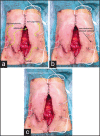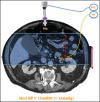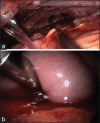Laparoscopic HIPEC: A bridge between open and closed-techniques
- PMID: 26917929
- PMCID: PMC4746985
- DOI: 10.4103/0972-9941.158965
Laparoscopic HIPEC: A bridge between open and closed-techniques
Abstract
Hyperthermic intraperitoneal chemotherapy (HIPEC) is currently delivered after cytoreductive surgery in patients with several kinds of peritoneal surface malignancies. Different methods for delivering HIPEC have been proposed all of them being variations between two modalities: the open technique and the closed technique. The open technique assures optimal distribution of heat and cytotoxic solution, with the disadvantage of heat loss and leakage of cytotoxic drugs. The closed technique prevents heat loss and drug spillage, increases drug penetration, but does not warrant homogeneous distribution of the perfusion fluid. A novel procedure that combines the advantages of the two techniques by means of laparoscopy is herein presented.
Keywords: Cytoreductive surgery; HIPEC; hyperthermic intraperitoneal chemotherapy; peritoneal carcinomatosis; peritoneal surface malignancy.
Conflict of interest statement
Figures









References
-
- Ahmed S, Stewart JH, Shen P, Votanopoulos KI, Levine EA. Outcomes with cytoreductive surgery and HIPEC for peritoneal metastasis. J Surg Oncol. 2014;110:575–84. - PubMed
-
- Bao P, Bartlett D. Surgical techniques in visceral resection and peritonectomy procedures. Cancer J. 2009;15:204–11. - PubMed
-
- Glehen O, Cotte E, Kusamura S, Deraco M, Baratti D, Passot G, et al. Hyperthermic intraperitoneal chemotherapy: Nomenclature and modalities of perfusion. J Surg Oncol. 2008;98:242–6. - PubMed
-
- Sommariva A, Zagonel V, Rossi CR. The role of laparoscopy in peritoneal surface malignancies selected for hyperthermic intraperitoneal chemotherapy (HIPEC) Ann Surg Oncol. 2012;19:3737–44. - PubMed
LinkOut - more resources
Full Text Sources
Other Literature Sources
